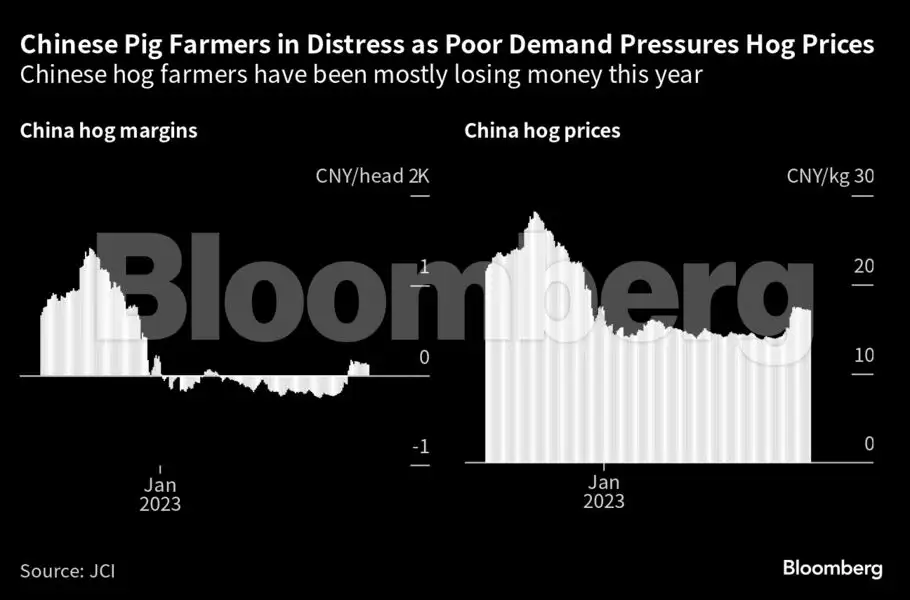Commodities have so far held up better than other assets as the economy has worsened. Freed from the constraints of the pandemic, fuel consumption has risen. Expectations that the government will be forced to amp up stimulus to rescue growth, as well as the onset of a seasonal recovery in demand, have also buoyed some markets.
But the backdrop remains worrisome. Traders are contending with a protracted crisis in the property market, deflation, weak exports and a falling yuan. Structural challenges include the government’s desire to pivot to an economy led by consumption instead of investment — helpful for fuel and food demand but not for old economy metals driven by construction.
China’s explosive spending on clean energy offers one salve, lifting consumption of materials linked to the green transition such as copper. But there are always trade-offs, in this case reduced demand for fossil fuels.
Base Metals
Base metals have retreated from their January high as the economy has lost steam, crushing margins at smelters and fabricators. The drop in profitability in the first half is their worst performance in over a decade. Industrial profits data for July is due on Sunday and is likely to show more pain in the sector.
 Bloomberg
BloombergThe plunge in margins at fabricators, especially for aluminium, is “a result of vicious competition, a price war in some segments,” said Wang Rong, an analyst at Guotai Junan Futures Co.
At the same time, inventories of copper and aluminium, the most widely used base metals, have dropped, with stockpiles of the former near critical levels, according to Goldman Sachs Group Inc. As traditional drivers of consumption have stalled, “new sources of growth from clean energy sectors have supported metal demand,” ANZ Group Holdings Ltd. said in a note this month.
Iron & Steel
Construction accounts for as much as 40% of China’s steel demand, and iron ore, the main input for blast furnaces, is a totem of the old economy. Bets on stimulus have helped keep prices above $100 a ton, although a reluctance to load up local governments with even more debt undermines the case that Beijing will resort to another big splurge on public works.
 Bloomberg
BloombergSeasonal demand is picking up as the summer lull passes into the so-called golden months for building activity, lifting run rates at blast furnaces and shrinking stockpiles of ore. Even so, the state of the property market means steelmakers are probably going to be cautious about tapping more imports to replenish supplies, said Steven Yu, an analyst at Mysteel.
“While this could leave mills highly exposed if there is a sudden recovery in downstream steel demand, this is a relatively moot point given the poor health of China’s industrial economy,” said Atilla Widnell, managing director of Navigate Commodities Ltd.
Crude Oil
Crude oil shipments were a bright spot among China’s commodities imports in the first half, and demand growth this year is expected to account for 40% of the global total. But the recovery may now be running on fumes as refiners throttle back imports and switch to running down inventories.
 Bloomberg
BloombergThe need to replenish stockpiles could yet reignite imports, which dropped to a three-month low in July. But a lot of the demand for oil products is showing up in export markets, rather than at home. China’s diesel exports in July, for example, more than tripled from the prior month.
Domestically, the picture is bleaker. Diesel consumption is being pegged back by weak industrial activity, while gasoline demand is challenged by faster adoption of electric vehicles. China’s petrochemicals sector, maker of plastics and rubber, saw a rare decline in sales and profits in the first half and remains heavily dependent on the health of the property market.
Coal & Gas
China’s economic activity is underpinned by coal, its mainstay fuel. Beijing has boosted both output and imports to drive a rebound that has ultimately disappointed, creating a glut that has left prices languishing.
 Bloomberg
BloombergNow that peak summer cooling needs have passed — air-conditioning is a major drain on electricity supplies — power plants could opt to dump inventory if industrial indicators remain gloomy, further pressuring the market.
China’s economic malaise is also likely to rein in the breakneck pace of inbound shipments, which have nearly doubled from last year. Purchases of liquefied natural gas, an alternative fuel, are also likely to slow given coal’s abundance. The depreciation of the yuan, which makes commodities billed in dollars more expensive, is another headwind for buyers.
Pork
The reopening of the economy after the government’s stringent measures to control the pandemic didn’t quite deliver the celebratory feasting on China’s favourite meat that many had expected. Instead, households conserved cash as economic uncertainties mounted.
 Bloomberg
BloombergThe weaker market for pork has ramifications for the wider economy. The meat has a heavy weighting in the basket of food prices, which was a big contributor to July’s lapse into consumer deflation.
The disappointing recovery has left pig farmers mostly loss-making for the year, and the pork market in surplus. Festival season, which begins with the National Day holidays at the start of October and runs through Chinese New Year, will be the next test of the public’s appetite for discretionary spending on pricier foodstuffs.







